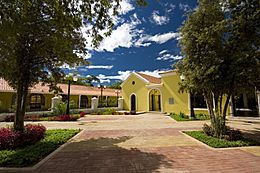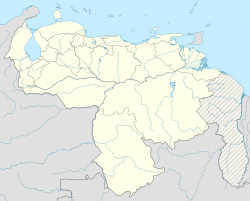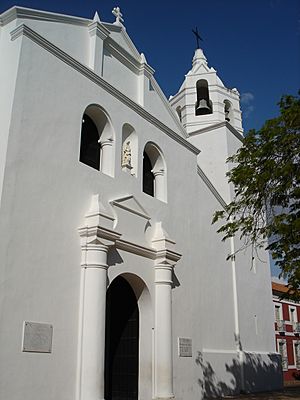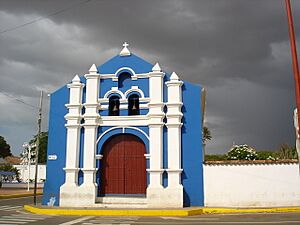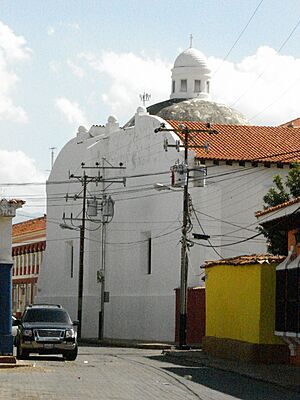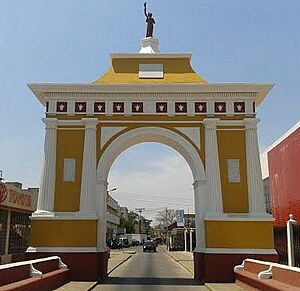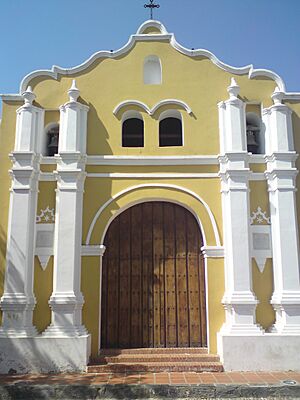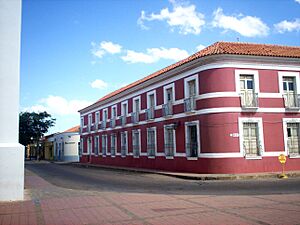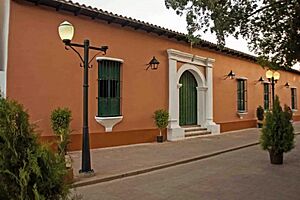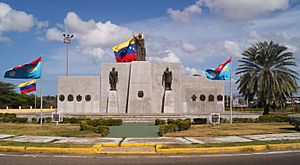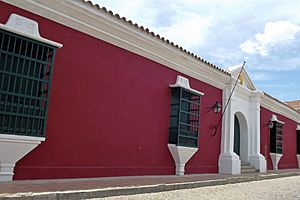Coro, Venezuela facts for kids
Quick facts for kids
Coro
Neu-Augsburg
|
|
|---|---|
| Santa Ana de Coro | |
|
Historic centre of Santa Ana de Coro, service station, museum, Los Médanos de Coro, and street of Coro.
|
|
| Country | |
| State | Falcón |
| Municipality | Miranda |
| Population
(2022)
|
|
| • Total | 195,227 |
| Climate | BWh |
| UNESCO World Heritage Site | |
| Official name | Coro and its Port |
| Criteria | Cultural: iv, v |
| Inscription | 1993 (17th Session) |
| Endangered | 2005 - |
| Area | 18.4 ha |
| Buffer zone | 186.3 ha |
Coro is an important city in Venezuela. It is the capital of Falcón State. It is also the second oldest city in the country, after Cumaná.
The city was founded on July 26, 1527. It was named Santa Ana de Coro by Juan de Ampíes. For a while, from 1528 to 1546, it was known as Neu-Augsburg. This was because a German family, the Welsers, controlled the area. Coro's buildings were built during the time of the Spanish Empire.
Coro is located in a flat area near the coast. To the north, you'll find the famous Médanos de Coro National Park. To the south are the mountains of the Sierra de Coro. The city is also close to its port, La Vela de Coro, on the Caribbean Sea.
Coro has a rich cultural history. It was one of the first cities founded by Spanish explorers in South America. It was also the first German colony in the Americas. Later, it became the first capital of the Spanish Captaincy General of Venezuela. It was also home to the first bishopric (church district) in South America. Coro is seen as the birthplace of Venezuela's movement for independence.
Because of its history and well-preserved old buildings, "Coro and its port La Vela" became a World Heritage Site in 1993. This means it's a special place recognized by UNESCO. However, since 2005, it has been on UNESCO's List of World Heritage in Danger.
What's in a Name?
When Coro was founded, it was called Santa Ana de Coro. This was a common Spanish way to name new cities. They often used a saint's name combined with a local Indian name.
The word coro is believed to come from the Caquetio word curiana. This word means "place of winds." However, some sources suggest coro might also mean "wind from the northwest" in Spanish.
Coro's Story
Early Days
Coro was founded on July 26, 1527, by Juan Martín de Ampués. He made an agreement with the local Caquetio people to respect their leader, Manaure. But this agreement was broken in 1529. That's when Ambrosius Ehinger arrived. He was the first governor representing the Welser family from Germany.
The Welsers were a banking family from Augsburg. The emperor Charles V gave them control of the Province of Venezuela. They were supposed to explore, build cities, and use the resources of this large area. Many expeditions left Coro to explore Venezuela and Colombia. They were searching for the legendary El Dorado. The Welsers' control ended in 1545. This was due to broken agreements and conflicts with Spanish explorers.
Coro was an important starting point for the Spanish. From here, they launched expeditions to explore and found new towns. However, Coro lost its role as the capital of the Venezuela Province in 1578. This happened because of repeated attacks by pirates. The harsh climate also played a part. The city also stopped being the seat of the bishopric in 1636.
Challenges and Comeback
In the 1600s, Coro faced tough times. A hurricane hit the city, and pirates invaded. English and French maps even showed it as "destroyed." But the surrounding countryside remained strong. This allowed the city to slowly recover. By the late 1700s and early 1800s, Coro reached its peak. Many of the beautiful colonial buildings we see today are from this time.
In 1795, there was a slave uprising in the Sierra de Coro. It was led by José Leonardo Chirino. The goal was to end slavery and create a republic. This movement was an early step towards Venezuela's independence. However, it was defeated, and Chirino was captured and killed.
Road to Independence
In 1806, Francisco de Miranda landed at La Vela de Coro. He led an expedition to free Venezuela from Spanish rule. The local people didn't welcome him with much excitement. But his expedition was still very important. It was a first step towards the Spanish American wars of independence. It also brought the tricolor flag to Venezuela. This flag later became the basis for the flags of Colombia, Venezuela, and Ecuador. La Vela de Coro was the first place this flag was raised in Venezuela.
At the start of the Venezuelan War of Independence, Coro remained loyal to Spain. It became a stronghold for the Spanish Empire. But in 1821, Coro finally joined the independence movement. The city was captured by troops led by the heroine Josefa Camejo.
The wars for independence and later civil wars in the 1800s left Coro damaged. The city and its surrounding areas were deserted. This led to a long period of decline. Coro only began to recover in the mid-1900s. This was when oil refineries were built nearby. Venezuela also changed from a rural country to an urban, oil-rich nation.
Since the early 1950s, Coro has been recognized as a National Heritage site.
Coro's Location and Climate
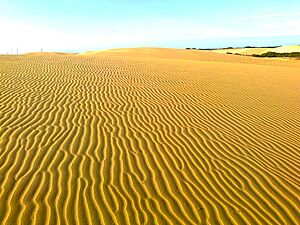
Coro is located in northern Falcón state. It sits on a flat coastal plain. This area has dry, desert-like plants. To the north is the Médanos Isthmus. This area is famous for its large sand dunes. These dunes are formed by strong winds and ocean currents. The isthmus connects the Paraguaná Peninsula to the mainland. South of the city, you'll find the foothills of the Sierra de Falcón mountains.
Weather in Coro
Coro has a hot, semi-arid climate. This means it's very warm and dry. It gets about 452 millimetres or 18 inches of rain each year. Most of the rain falls between October and December. March is usually the driest month. The average temperature is around 28.9 °C (84.0 °F). Temperatures can range from 23 °C (73 °F) to 36 °C (96.8 °F).
Coro is a very sunny city, with over 3100 hours of sunshine a year. January is the sunniest month. Strong winds are common, sometimes reaching speeds of 35 kilometres per hour (22 mph; 19 kn). On April 29, 2015, Coro recorded Venezuela's highest temperature ever: 43.6 °C (110.5 °F). The temperature in Coro has never dropped below 18.9 °C (66.0 °F).
| Climate data for Coro (1991–2020, extremes 1961–2020) | |||||||||||||
|---|---|---|---|---|---|---|---|---|---|---|---|---|---|
| Month | Jan | Feb | Mar | Apr | May | Jun | Jul | Aug | Sep | Oct | Nov | Dec | Year |
| Record high °C (°F) | 37.8 (100.0) |
37.8 (100.0) |
41.6 (106.9) |
43.6 (110.5) |
41.4 (106.5) |
43.0 (109.4) |
43.2 (109.8) |
45.0 (113.0) |
45.0 (113.0) |
41.8 (107.2) |
39.3 (102.7) |
40.5 (104.9) |
45.0 (113.0) |
| Mean daily maximum °C (°F) | 29.9 (85.8) |
30.1 (86.2) |
31.4 (88.5) |
31.9 (89.4) |
32.7 (90.9) |
33.0 (91.4) |
32.9 (91.2) |
33.9 (93.0) |
34.0 (93.2) |
32.3 (90.1) |
31.3 (88.3) |
30.3 (86.5) |
32.0 (89.6) |
| Daily mean °C (°F) | 26.8 (80.2) |
27.2 (81.0) |
27.8 (82.0) |
28.6 (83.5) |
29.3 (84.7) |
29.4 (84.9) |
29.2 (84.6) |
29.8 (85.6) |
29.8 (85.6) |
29.1 (84.4) |
28.4 (83.1) |
27.4 (81.3) |
28.6 (83.5) |
| Mean daily minimum °C (°F) | 23.8 (74.8) |
24.0 (75.2) |
24.6 (76.3) |
25.6 (78.1) |
26.3 (79.3) |
26.5 (79.7) |
26.2 (79.2) |
26.6 (79.9) |
26.7 (80.1) |
26.2 (79.2) |
25.6 (78.1) |
24.6 (76.3) |
25.6 (78.1) |
| Record low °C (°F) | 19.5 (67.1) |
19.0 (66.2) |
19.0 (66.2) |
21.1 (70.0) |
20.4 (68.7) |
21.8 (71.2) |
20.0 (68.0) |
21.6 (70.9) |
20.5 (68.9) |
20.0 (68.0) |
20.8 (69.4) |
18.8 (65.8) |
18.8 (65.8) |
| Average rainfall mm (inches) | 24.5 (0.96) |
19.9 (0.78) |
21.8 (0.86) |
19.0 (0.75) |
24.8 (0.98) |
26.8 (1.06) |
33.5 (1.32) |
39.3 (1.55) |
43.7 (1.72) |
83.9 (3.30) |
65.2 (2.57) |
57.0 (2.24) |
459.4 (18.09) |
| Average rainy days (≥ 1.0 mm) | 3.4 | 2.3 | 1.3 | 1.4 | 1.2 | 4.3 | 4.1 | 4.9 | 6.1 | 8.3 | 6.3 | 7.6 | 50.2 |
| Average relative humidity (%) | 69.0 | 68.5 | 67.0 | 69.0 | 68.5 | 68.0 | 67.5 | 67.0 | 67.0 | 70.5 | 72.0 | 71.0 | 68.8 |
| Mean monthly sunshine hours | 291.4 | 268.8 | 288.3 | 234.0 | 248.0 | 255.0 | 285.2 | 288.3 | 261.0 | 251.1 | 252.0 | 266.6 | 3,189.7 |
| Mean daily sunshine hours | 9.4 | 9.6 | 9.3 | 7.8 | 8.0 | 8.5 | 9.2 | 9.3 | 8.7 | 8.1 | 8.4 | 8.6 | 8.7 |
| Source 1: NOAA (sun 1971–1990) | |||||||||||||
| Source 2: Instituto Nacional de Meteorología e Hidrología (humidity 1970–1998) | |||||||||||||
Protecting Coro's Heritage
Coro has amazing old buildings from colonial times. They show a mix of styles. You can see features from southern Spain (Andalusia). But they also use building methods from Native Americans, like adobe (mud bricks) and wattle (earth reinforced with plants). This gives Coro a special look.
The city's layout is also unique. It combines the Spanish checkerboard pattern with an irregular shape. This irregular shape is typical of medieval German cities. It comes from the time when the Welser family controlled Coro. Over 600 buildings in Coro are protected as heritage sites.
The historic center still looks like a city from the 1700s and 1800s. It has cobbled streets and many traditional buildings. It's a major colonial city with many old churches. Coro is sometimes called "the museum city" because it has so many museums and historical sites. For all these reasons, Coro and its port, La Vela de Coro, were named a World Heritage Site by Unesco in 1993.
However, since 2005, Coro has been on the "List of World Heritage in Danger." This is because of several issues. Heavy rains, especially between 2004 and 2005, have damaged its old buildings. Coro's traditional buildings are made of earth. This material is not very strong against moisture.
Also, UNESCO has been concerned about new constructions. Some new walls, fences, and beach walkways might affect the site's historical value. In 2018, progress was noted in protecting the site. But more work is still needed to keep Coro's unique heritage safe.
Famous Places to Visit
Coro offers many interesting places for visitors. You can explore its historic buildings or enjoy its natural beauty.
- Médanos de Coro National Park: To the northeast of the city, you'll find huge sand dunes. This is Venezuela's only desert. They are located along the road to La Vela de Coro.
- Colonial Town: This World Heritage Site has cobbled streets and hundreds of historic buildings. Some buildings show a Mudéjar style. Others show the influence of the Netherlands from the nearby island of Curaçao.
Here are some specific buildings and places you can visit:
This is one of Coro's main churches. Building started in 1531. Pirates attacked it in 1567. The current building dates from 1583 and was finished in the late 1600s. This makes it the oldest Catholic church on the South American mainland.
- Casa de las Ventanas de Hierro
This grand mansion was built in the 1600s. It's known for its large windows. These windows are protected by beautiful wrought iron. The iron was brought from Spain.
- Iglesia y Convento de San Francisco
This religious complex includes a church and a former monastery. The monastery now houses the Diocesan Museum "Lucas Guillermo Castillo". The church was started in the 1500s. Its tall, neo-Gothic tower is over 50 meters high. It is the tallest tower in the area.
- Iglesia de San Clemente
This church was first built in the 1500s by the city's founder, Juan de Ampíes. It has a unique cross shape. Each end points to a central spot. It's one of the few colonial buildings in Venezuela built in this cross shape.
- Casa del Tesoro
This mansion was built in 1770. It is said that a treasure is buried on its land, but it has never been found.
- Alberto Henríquez Museum of Art
This building was once the home of a Spanish official. Later, in 1847, a Jewish merchant bought it. He built the Coro Synagogue here. This is one of the oldest synagogues in Latin America. Today, the synagogue is part of the Alberto Henríquez Museum of Art. This museum belongs to the Universidad Francisco de Miranda.
- Balcón de los Arcaya
This large, two-story building has a wooden balcony. It was built in the 1700s as a family home. It now houses the People Earthenware Museum.
- Balcón de Bolívar
Also known as Balcón de los Senior. This building served as a military headquarters during the War of Independence. It is said that Simón Bolívar, a famous leader, stayed here in 1826. He greeted patriots from its balcony. Today, it houses the Coro Art Museum.
- Cruz de San Clemente
This cross marks the spot where the first Mass in South America is believed to have taken place.
This is the oldest Jewish cemetery in South America. It started in the 1800s when Jewish families from Curaçao moved to Coro. It has beautiful old tombs.
- Iglesia del Carrizal
This church holds the image of the Virgin of Guadalupe of Carrizal. Legend says it was found by Native Americans in 1723 after a ship sank.
- Casa del Sol
This is one of Venezuela's oldest houses, built in the 1600s. Its name, "House of the Sun," comes from a sun symbol above its door.
- Iglesia San Nicolás de Bari
This church was built in 1741 by a Spanish lady. It is located west of the historic center.
- Arco de la Federación
This monument honors Marshal Juan Crisóstomo Falcón. He was a leader during the Federal War and later President of Venezuela.
Exploring the Area Around Coro
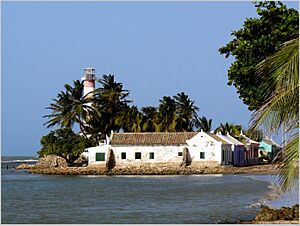
If you travel an hour north of Coro, you'll find beaches famous for windsurfing in the Paraguaná Peninsula. An hour south, the "La Sierra de Coro" mountains offer cooler weather and views of the city. On clear days, you can see the médanos (dunes) and the Paraguaná Peninsula.
To the west, you can visit Urumaco, an important place for finding fossils. The Sierra de San Luis National Park is about 30 kilometres (19 mi) south. It's great for birdwatching and seeing nature. You can also find caves and waterfalls there.
Coro's Economy
Coro's economy mostly depends on money spent by the state government. The main activities in the city are retail (shops), construction, tourism, and professional services.
|
See also
 In Spanish: Coro (Venezuela) para niños
In Spanish: Coro (Venezuela) para niños


